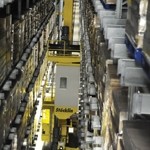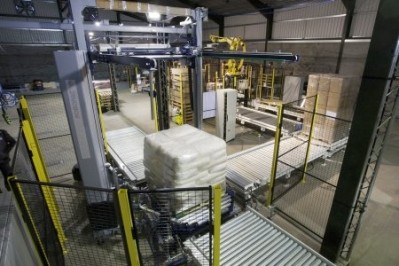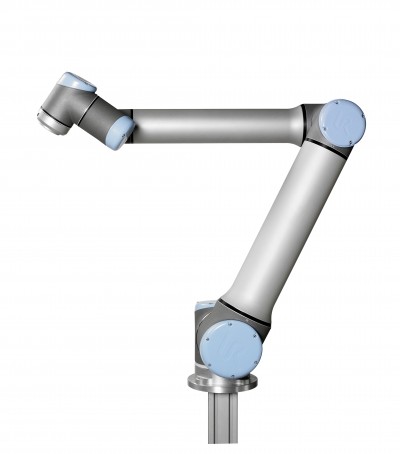Food firms keeping quiet about automation

The secret is out: UK food manufacturers have wised up to the cost-saving powers of buying a shiny new robot. The trouble is, they would rather nobody knew about it.
British Automation & Robot Association (BARA) figures state that the number of robots sold into the food and drink sector soared by 28% in 2013. In fact, nearly as many were supplied in the first half of the year as in the whole of 2011.
So why are so few converts shouting about it? The answer lies with the eagle-eyed supermarket buyer lurking at the goods-out gate with a sharpened pencil and a calculator.
“What we discovered (upon surveying food manufacturers) was that many were reticent to make public the fact that they wish to automate; they complain that the biggest multiple retailers use the fact that they have automated to squeeze their margins further,” says Grant Collier, head of marketing at BARA. “Some companies have gone to great lengths to avoid publicity.”
He warned of supermarkets causing an “ever-increasing blockage in the supply chain and a barrier to automation in the UK”. Not helpful, when adoption of automation is already well behind other major European countries, and, indeed, some emerging markets.
“The frustration is that other countries, like Germany and the US, put more of a research and development (R&D) slant on their investment programme,” says Keith Thornhill, food and beverage business manager at Siemens. Typically, the UK has a tenth of Germany’s R&D innovation in general manufacturing, he estimates.
There is a lot of lost ground to make up. The UK automotive industry bought 11 times as many robots last year than food and drink firms – despite the grocery sector being valued at some 15 times more than the automotive sector.
Next big industry (Return to top)
“The food industry has always been seen as the next big industry for robotics to make inroads into it’s much bigger than automotive; 60% of the prospects I’m pursuing are food related there is huge potential and it’s starting to happen,” says Bob Lloyd of Kawasaki Robotics.
Part of the problem has been the short-termism of retail contracts and payback times on capital investments that are hard to quantify.
“Manufacturing 300,000 cars a year, [you have] a clearly defined payback time,” says Chris Sumner, md of Fanuc Robotics UK. “Supermarkets have [food manufacturers] on very short contract periods so they have no guarantee of that manufacturing requirement, which is why the robot needs to be a flexible machine that can be adapted to different processes.
“You can changeover from doing cakes to pork pies to sausage rolls easily with half a dozen manual workers moving from one line to another. So there’s a big mental change in investing an amount of money on something that isn’t as flexible as they're used to. But a lot of countries abroad have shown success with it. And food can now be sourced quickly from abroad so [the danger is] supermarkets may look overseas,” he adds.
Robot technology exists to cover the process from controlling ingredients and dosing, to minimising waste, through to tray handling, packaging and palletising; but it is the knowledge needed to deploy robotics that has been the major stumbling block, which is where the issue of lost skills arises.
Robotics supplier Knight Warner now has an apprenticeship scheme to bring in young people to do foundation degrees “to repair the gap of 10 or 15 years” lost to other countries, says director Dave Knight.
Meanwhile, BARA has run the Automating Manufacturing programme, in which the government made £600,000 available for independent experts to go into factories and advise how they should be automated to remain competitive. By far the largest proportion of participants were from the food sector, accounting for 37% of the 367 firms involved.
Application of automation (Return to top)
The programme was borne out of recommendations made in a 2010 study, Application of Automation in UK Manufacturing, which polled manufacturers of engineered products and food in Spain, Germany, Sweden and the UK. Commissioned by members of the Engineering & Machinery Alliance with support from the Department for Business, Innovation and Skills, the study concluded that the main reason behind UK manufacturers' reluctance to invest in new manufacturing technologies was a lack of knowledge, skills and confidence.
Free audits of the manufacturer’s operation were offered and opportunities to apply automation were identified, followed by implementation support. This has gone some way to raising awareness of robotics and addressing concerns that have prevented manufacturers from automating.
“[Growing] the skills that are required to understand how you can put the automation in and make the most out of it is important,” says Thornhill, who sees renewed uptake in areas with traditionally low levels of automation such as bakery and dairy. “Some cross-fertilisation is taking place: guys who were in the automotive industry are cropping up in food processing and packaging,” he notes. “That is leading to a complete, holistic approach to the factory, with highly automated bakeries and dairies, rather than a piecemeal approach. The benefits in terms of agility of manufacturing are superb.”
The reason why robot sales in food and drink are up some 70% on 2000 is also the shortening payback times, from three years a decade ago to typically a year. “All the robot vendors have been beaten up by the automotive suppliers,” says Bob Lloyd. “And they will not accept breakdowns, so you can pretty much guarantee the robot will be the most reliable kit that you've got.”
The easy wins in automating are end-of-line packing and palletising –the area all robotics suppliers are united in saying has the greatest potential for development. Fanuc’s robot redevelopment programme, for example, has resulted in a 20% reduction in parts on the latest palletising and pick-and-place models – the most common applications for robots in food manufacture – while cutting costs.
“The manufacturing process itself is less an area of focus than end-of-line,” adds Knight. “It’s all about getting the product to the supermarket just-in-time or on time. And the two holding points are at the start and the end of the process.”
One of the challenges for small and medium-sized manufacturers is maximising production line efficiency while meeting the short timescale demands of retailers. “This means the investment made in end-of-line automation has to include the flexibility to handle short runs of multiple product types with minimum changeover time and minimum line stoppages,” explains David Jahn, director of Brillopak. This has driven the firm to develop a range of compact pick-and-place and palletising systems designed for fast changeover and high-speed production.
This is also a measure of robots becoming increasingly suitable for food manufacturing environments; the very nature of a robot arm, with its many crevices and less durable construction materials, has in the past prevented it from working in extreme environments. But many palletising and pick-and-place systems are now IP67K or IP69K certified, for full washdown.
Simpler interfaces (Return to top)
Meanwhile, the interface between the robot and the system is becoming simpler. “Robots were seen as something strange and different, but what is happening now is the robots will quite happily be driven by the programmable logic controllers (PLCs),” says Lloyd. “You’ve always been able to have an interface to the PLC, whether Allen Bradley, Rockwell, Siemens, Mitsubishi or whatever. But what’s happening now is, for instance, you can have the Rockwell Ethernet IP [internet protocol] standard network embedded in the robot controller, and it becomes an extension of what you’ve already got in your process. The robot is becoming just a component part slightly more sophisticated but the interface is the same. It takes a barrier away for the food guys.”
The ease with which a robot can be redeployed is also being made simpler by developments in controller technology. “As manufacturing control systems evolve, our customers are replacing ageing equipment with simplified systems,” says Geoff Sieron, product manager of GuardLogix controllers, Rockwell Automation. “Quick-connect cabling greatly streamlines system wiring so the system is easier to install, troubleshoot and maintain. This can be especially crucial to machine and equipment builders looking to improve time-to-market, testing and commissioning.”
So what of the future? Is the automation trend set to continue? “We had our best year on food (automation) to date last year, across all areas,” says Alan Spreckley of ABB. “What I am particularly pleased about is the number of small-to-medium enterprises dipping their foot in the water with one or two robots. People's confidence in the technical side is increasing because they’re seeing more and more of their competitors doing it and making more profit. It is a cut-throat industry with a high throughput, low-value product in many cases, where fractions of pennies per item can make a big difference.”
Hopefully some of those pennies will find their way into the food manufacturers' pockets rather than the supermarkets’ coffers.















